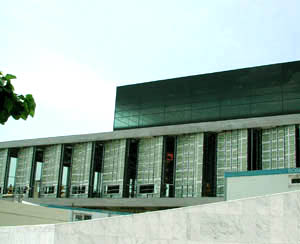By the President of the Organization for the construction of the New Acropolis Museum, Dimitrios Pandermalis, Professor of Archaeology

A model of the Acropolis Rock Foto: Inger Eriksson
The construction of a new museum to house all the surviving antiquities from the Acropolis has been Greece's objective for over three decades. Almost as soon as it was first built in the 19th century, the existing museum on the Acropolis became too small for the wealth of antiquities recovered on the Acropolis. As a result many of the finds are displayed in other Athenian museums or are in storage. The limitations of the existing museum, the extraordinary significance of the finds and the effort to reunify all the surviving pieces of the unique architectural sculptures of the Parthenon made the construction of a new museum an imperative.
Today the construction of the New Acropolis Museum at the southern foot of the Acropolis is progressing with building completion planned in the summer of 2007 and the transport of the museum exhibits from the Acropolis to the new Museum commensing soon after.
The Museum takes its shape and form from the archaeological excavation on the contruction site, the relationship of the crown of the building - the Parthenon Gallery, to the Parthenon itself and the exhibits themselves.
MUSEUM SPACES
Over 14,000 m2 of exhibition space is provided as compared to the 1,450 m2 of the existing Acropolis Museum up on the Rock.
The Parthenon Gallery has a floor of 3,200 m2, while the double story Archaic Gallery soars to a ceiling height of 10 meters over a floor space of almost 1,500 m2.
Over 7,000 m2 of land has been freed up through expropriations on the periphery of the site and will become green and landscaped areas.
Approxamately 4,000 m2 of the Museum is committed to visitor services.
MUSEUM AMENITIES
The New Acropolis Museum will offer all the amenities expected of an international museum of the 21st century. Visitor services dominate the ground floor level where the visitor is welcomed into a large lobby where the museum store, a cafe overlooking the archeological excavation, the 200 seat auditorium, the temporary exhibition space and the virtual reality theatrette are located. The mezzanine hosts the Museum's multimedia lounge and the museum restaurant with its public terrace commanding panoramic views of the Acropolis.
The Museum is fully accessible to people with physical disabilities.
MUSEUM LOCATION
The New Acropolis Museum is located in the historical area of Makriyianni, south east of the Acropolis Rock. Only 300 meters from the Acropolis and approximately two kilometers from Syntagma - Athens' main city square and public transport hub, the Museum is directly linked to the Athens Metro by the Acropolis station, located on the eastern border of the Museum site.
The Museum is entered from the pedestrian walkway of Dionysiou Areopagitou at the commencement of over 4 kilometers of pedestrian walkways that link the key archaeological sites of the city.
The entrance to the Acropolis directly opposite the Museum's entrance makes it possible for visitors to make an easy connection between the Acropolis and its new Museum.

The east front of the New Acropolis Museum will also
include the entrance. The Museum entrance can easily
be reached by Athens Metro.
(Building under construction)
Foto: Inger Eriksson
The base of the Museum moulds to the perimeter of the archaeological excavation. The buildning hovers on over 100 concrete pillars forming an impressive underground shelter for the archaeological ruins.
The architect's solution for the exhibition of the Parthenon frieze is a core design element of the building. A rectangular solid concrete core penetrates the building from ground level upwards to the third and final floor of the building. Here it serves as the cella on which the frieze of the Parthenon will be mounted. The core has the same dimensions and the same directional orientation as the Parthenon cella, resulting in the Parthenon Gallery being at an angle to the rest of the building below. The interior of the concrete core provides discreet space for Museum service areas and electromechanical installations at all floor levels.
The building design fulfills the Construction Authority's requirement that visitors shall be able to see the monument from the Gallery exhibiting the Parthenon frieze through the design of the Gallery as a monumental glass box. Breathtaking views of the Acropolis are made available with a 360-degree panorama of modern and historic Athens from every side of the Gallery.
THE EXHIBITION PROGRAM
For the first time since archaeological excavations have been completed all the significant findings from the Acropolis will be consolidated in the one Museum, telling the complete story of life on the Athenian Acropolis and its surrounds. From prehistoric through to the highpoint of the Classical Period and the Parthenon, to artefacts created during the Roman Period and late Antiquity - rich collections will provide visitors with a comprehensive picture of the human presence on the Acropolis. The extensive remains of the ancient Athenian city revealed on the Museum site by pre-construction archaeological excavations, will also grace the Museum exhibition program.
A MUSEUM OF SCULPTURE AND LIGHT

A model of the New Acropolis Museum and its surrounds.
On top of this area a model of exhibited sculptures.
Foto: Inger Eriksson
Although boasting a wide range of exhibits including ceramics, bronzes and coins, the New Acropolis Museum is principally a museum of sculpture. Many of the sculptures are architectural pieces, originally adorning the monuments of the Acropolis, seen under all the variations of daylight. The appreciation of these variations in the sculptures is assured for the visitor through the extensive use of glass in the Museum's design.
Länkar:
Arkitektkontoret Arcspace/Tschumi
Find Articles >>
On New Acropolis Museum/3D
Columbia News on NAM
More about New Acropolis Museum
Den brittiske konstskribenten Dr Tom Flynn om Nya Akropolismuseet